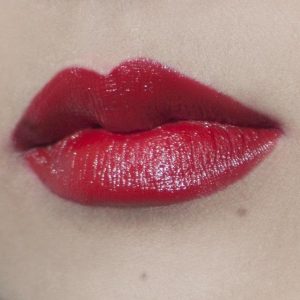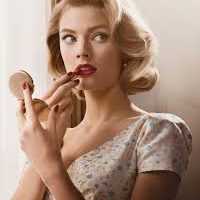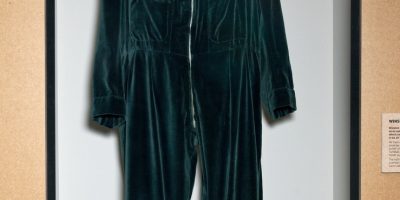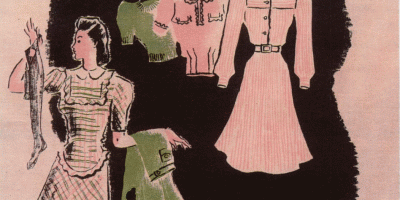
Beauty With a Purpose
The Power of Red Lipstick
Word War II was a “People’s War” which meant that everyone, even women had to do their part. Although there were shortages on cosmetics, women had to make do with what they had; however, they were also expected to maintain their beauty and their physical attributes. There were many propaganda campaigns encouraging women that “Beauty is their Duty” (Siracky). Even though the war was a difficult time, women had to dress up which served to brighten the moods of people, especially soldiers. For instance, bright red lipstick was commonly used as a tool to boost the morale of the public. “Red lipstick was seen as a symbol of patriotism during the time, not only did it make women feel more feminine, it made them feel like they were defying the difficult times that were happening around them” (“Can’t Help But Be”). It was important that people had hope that they could survive and win the war. Women with beauty was essential to remind soldiers what they were fighting for, to give them incentive, and to lift their spirits. In many vogue magazines and advertisements, women wore red lipstick.

Woman Wearing Red Lipstick for Vogue Magazine
The most common substitution for red lipstick was beetroot which formed a natural lip stain. The British government emphasized the message to women that looking beautiful was one major way of contributing to the war effort. On behalf of the government, magazines such as, British Vogue, “encouraged women to dress their best not only for the nation’s morale, but also for the boys fighting away from home, and to show resistance to the enemy” (“News Talk”). It was crucial for women to fulfill their obligations and duties to the war effort because it brought hope to their country, Britain. Aside from this, women dolling up was not part of the norm in Germany. In Germany with Hitler as ruler, the ideology was that women should wear plain clothing with no makeup (“Women in Nazi Germany”); thus, Britain was more eager to promote feminine glamour in order to oppose the enemy’s traditions.
When women went to work and took different jobs, they were expected to look pretty. Beauty in Britain during World War II was not something minor or something to be dismissed.

An Air Raid Precautions volunteer applies her lipstick between emergency calls (“Imperial War Museum”).
A woman not interested in their physical appearance “could be a sign of low morale, which could have a detrimental impact on the war effort” (“Imperial War Museum”). Pat Kirkham, a design historian, author, and a professor, describes a woman named Nella Last who kept a diary during the war. Last says that “using ‘too bright lipstick’ on dim days makes the corners turn up when the lips will not keep smiling” (Siracky). In other words, she did not need to smile or put on a “brave face” because the vibrant lipstick already had a strong, positive, and motivational impact on her as well as the public.
One propaganda message from the Vogue magazine in 1942 stated:
“To be as attractive as we can is almost a civic duty; there are so many sad and ugly things in the world that I think women should say to themselves humbly, not with vanity ‘I will try to be as pretty as I can, so that when people look at me, they will feel refreshed. I will make an effort to be easy on the eye” (“News Talk”).

The British government and media emphasized makeup; especially red lipstick as seen in this poster
One may not expect the significant role that women had to play in terms of dressing up and looking pretty; however, during World War II in Britain, doing so was essential to the success of the war. When the public saw an attractive and glamourous women, it dazzled their eyes and made the people remember that there was brightness and positivity in life. People were obviously going through dark times and they needed “women” to help them escape this darkness. Women were the ones that brought light to the people of Britain. A woman’s beauty was not just for their self-esteem; it was for soldiers far away fighting, and more importantly for their country. Lipstick added a special glow and spark to women which is what Britain needed to escape their pain and worries due to the war. Red lipstick brought light onto the lives of the British people, boosted their morale, and helped them to walk through the tough years.
Works Cited
“Beauty is Your Duty.” Newstalk.com, www.newstalk.com/Beauty-is-your-duty--The-British-womans-mantra-on-how-to-dress-during-WWII. “8 Facts About Clothes Rationing In Britain During The Second World War.” Edited by Laura Clouting, Imperial War Museums, 27 Feb. 2015, www.iwm.org.uk/history/8-facts-about-clothes-rationing-in-britain-during-the-second-world-war. “Make up in the 1940s.” Can't Help But Be, 14 Jan. 2010, canthelpbutbe.wordpress.com/2010/01/14/make-up-in-the-1940s/. Siracky, Hailey. “Here's What Happens When "Beauty" Becomes "Duty".” BuzzFeed, July 2014, www.buzzfeed.com/haileysiracky/beauty-as-duty?utm_term=.ktgPNnqkd#.knvjwNqZ9. “Women In Nazi Germany.” Spartacus Educational, Spartacus Educational, spartacus-educational.com/GERwomen.htm.







Melissa Dinsman
Very interesting post and beautifully presented! As I was reading I wondered if you had come across any advertisements for red lipstick during the war. And where would the women have learned about beet juice as a substitute? Did you find any articles or magazine pieces on it from the 1940s? Also, you mention that makeup was not really part of the German routine. Do you have a source for this?
Jack
I found many advertisements for red lipstick; however I was disappointed when I discovered that these ads were not from Britain, they were from the U.S. I have included one advertisement that I found that was used in Britain. I did not come across any more. As far as beet juice, I assumed that word must have gotten around and this is how more women used it as a substitute. I did not discover any specific articles explaining how this substitution came about; however, I know that women were constantly encouraged to look their best by whatever means possible. In fact, while I was doing research, I read something about women using shoe polish as mascara. Some may assume that this was too extreme since it wasn’t natural and could be harmful to the eye.